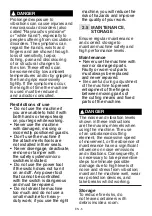
EN - 7
2.6 BATTERY / BATTERY
CHARGER
ATTENTION
The following safety rules
complement the safety
rules contained in the
battery charger manual.
•
Only use battery chargers
recommended by the
manufacturer to recharge
batteries. An inadequate
battery charger may cause
electric shock, overheating
or corrosive liquid to
leak from the battery.
•
Use only batteries specifically
designed for your power tool.
The use of other batteries may
cause injuries and fire risks.
•
Make sure that the machine
is switched off before inserting
the battery. Inserting a
battery in a machine which is
switched on can cause a fire.
• Keep all unused batteries at
a distance from paper clips,
coins, keys, nails, screws
or other small metal objects
as contact with the same
can cause short circuits.
Short circuits between
battery contacts can lead
to explosion or fires.
•
Do not use the battery
charger in places where
there are inflammable
vapours, substances or
on easily inflammable
surfaces like paper, fabric,
etc. During recharge, the
battery charger becomes
heated and may cause fire.
•
When transporting batteries,
make sure the contacts never
come into contact with each
other and never use metal
containers to transport them.
2.7 ENVIRONMENTAL
PROTECTION
Protecting the environment must
be a significant and top priority
for machine use, to the benefit
of civil co-habitation and of the
environment that we live in.
Avoid being an element of
disturbance to the surrounding
area. Use this machine at
reasonable times of the day
only (not early morning or
late evening when the noise
could cause disturbance).
Scrupulously comply with local
regulations for the disposal of
packaging, deteriorated parts
or any elements with a strong
environmental impact; this
waste must not be disposed
of with regular waste, but
must be separated and taken
to collection centres, which
will recycle the materials.
Comply with local regulations for
the disposal of waste materials.
When the machine is withdrawn
from service, do not dispose
of it in the environment, but
take it to a waste disposal
facility in accordance with the
local regulations in force.
Do not throw electrical
equipment away with
domestic waste. According
to the European Directive
2012/19/EU on electrical and
electronic equipment waste and
its implementation in compliance
with national standards, old
electrical equipment must be
collected separately, for eco-
compatible recycling. If electrical
equipment is disposed of in
Содержание BC 900 D Li 48
Страница 5: ...1 XX XX XX XX XX C A C B 3 A B 4 5 6 A D C B 7 8 A C B B D C A ...
Страница 6: ...1 XX XX XX XX XX 9 10 11 12 13 14 C D B B A B A C A B C A C B D E A ...
Страница 7: ...1 XX XX XX XX XX 2 1 3 15 16 17 18 19 20 ...
Страница 8: ...21 23 25 26 22 24 A B A B A B A ...
Страница 9: ...A C D B 27 28 A B A B C D A B 150 mm 6 in 150 mm 6 in B A B C 29 28 27 ...
Страница 44: ...ST S p A Via del Lavoro 6 31033 Castelfranco Veneto TV ITALY dB LWA Type s n Art N ...
















































